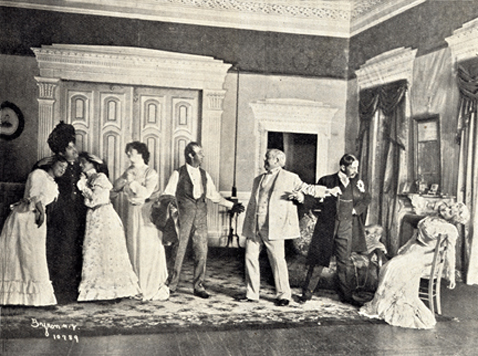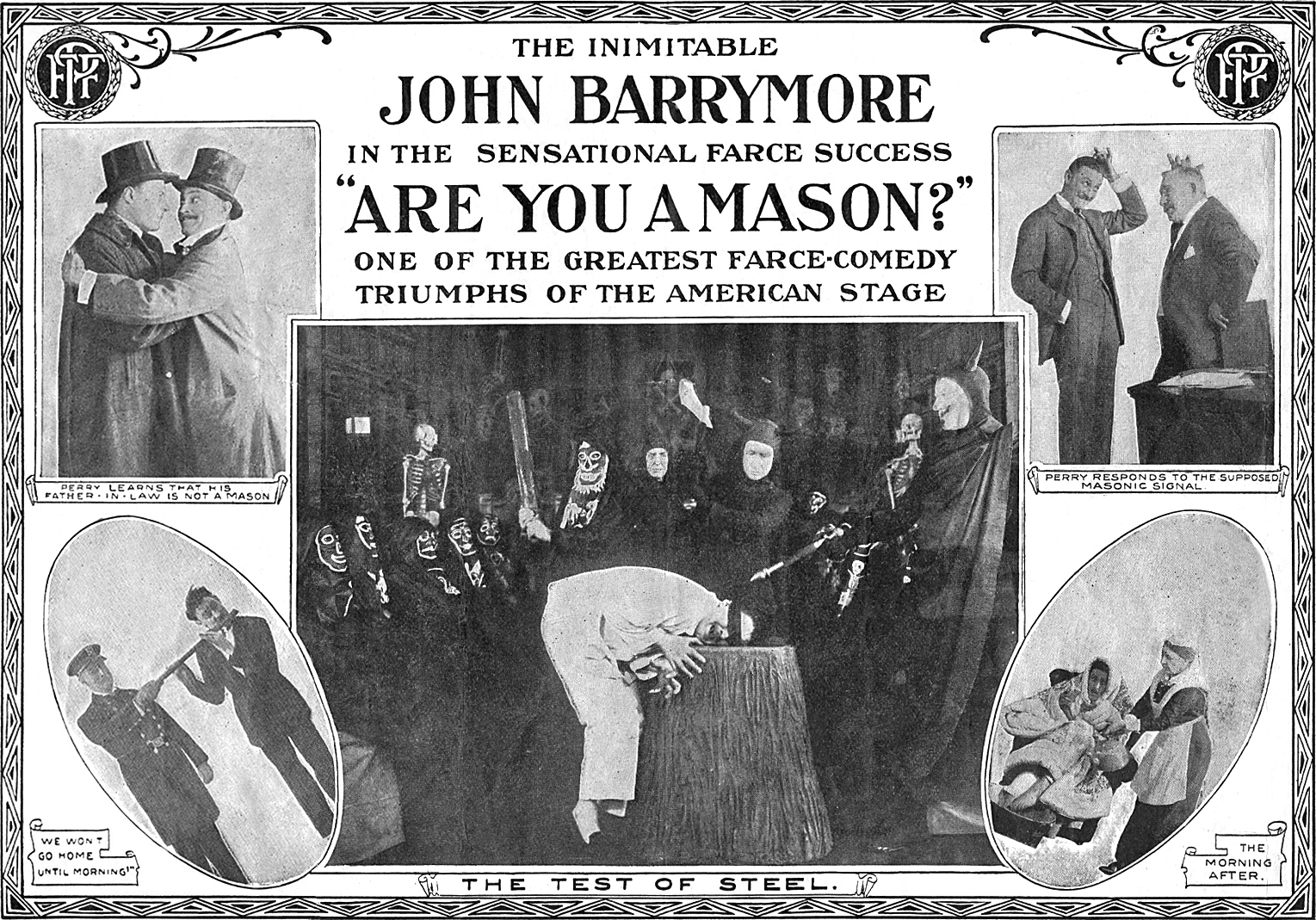|
|
|

Are you a mason?
By R.W. Bro. James G. Bennie (1 January 2007)
|
We all know the answer to that question, right? Then again, perhaps not. That's because it's not really a question at all. It's actually the title of a long-forgotten movie.
Our story opens on 6 January 1865 in Temesvar, Hungary. That's where one Leo Ditrichstein was born. He was the son of an Austrian nobleman and grandson of novelist Joseph Von Eltoos. He was educated in Vienna, but spent his early years in Berlin, where he made his stage debut. His reputation grew and he was coaxed into appearing in the U.S.
Ditrichstein spoke several languages, but learned English quickly while in the States. He joined John Drew's theatre company in New York, and made his stage debut in Die Ehre in 1890. He had great successes in Trilby and Hedda Gabler, but he also appeared in plays he wrote or co-wrote. He penned romances, dramas, melodramas — even a musical. But he also wrote comedies and one of them was called Are You a Mason?
The play was adapted from the German Die Logenbrüder written by Carl Laufs and Curt Kraatz. Somehow, Ditrichstein found backing for it — and the show went on at Wallack's Theatre, opening April Fool's Day 1901. He staged it and played one of the roles, but it was not a resounding success. It closed after only 32 performances. Ditrichstein mounted it again later that year. The play opened 19 August at the Garrick Theatre and closed again after only 32 performances. Considering three is a masonicly significant number, it's appropriate that he revived it for a third time. It premiered at the Garrick on 5 September 1904. This time, it lasted only 16 performances.
 Despite its spotty history on Broadway, the play must have been popular on the road — in fact, it played at the Alcazar in San Francisco the night before the earthquake. One touring version starred none other than The Great Profile — John Barrymore. Perhaps it was his presence which interested Famous Players in turning it into a movie in 1915, which also featured Jean Acker, later known as Mrs. Rudolph Valentino. It was released by Paramount on 22 March 1915, and was re-released in 1919. A planned remake in 1922 had to be abruptly shelved. That's because it was intended as a starring vehicle for Fatty Arbuckle, who was blacklisted in Hollywood after a murder he had nothing to do with, but one the newspapers whipped into a frenzy that today's entertainment tabloids can only envy.
When sound came in, many silents were re-made, and Are You a Mason? was no exception. It was filmed with a British cast in England in 1934 and released by two companies in the U.S. on a States Rights basis; that means companies purchased the right to distribute a movie to theatres in a specific state. In those days, the big movie companies owned their own theatres; most films released on a States Rights basis ended up in smaller houses.
Ditrichstein had nothing to do with the film productions except provide his play for use as a screenplay. He last appeared on the U.S. stage in 1924 and returned to Europe, living in Italy and Austria before dying of heart disease in Vienna on 28 June 1928 at the age of 63.
So, what was the plot? Being a farce, it was a case of mistaken identity involving a couple of men pretending to be freemasons. However, movie studios are apt to fiddle with things — in fact, the title of the silent version was The Joiner in one of the releases. Barrymore plays a young bridegroom who manages to get out of all sorts of scrapes by pretending to be a freemason, supremely confidant that he'll either be rescued or forgiven by his "fellow" freemasons. Ah, but things get hairy when it turns out that Barrymore's new father-in-law has likewise been posing as a freemason for years, and for many of the same reasons. Hoping to make the material more "cinematic," director Thomas M. Heffron attempted at one point to stage a drunk scene from the drunk's point of view. Incidentally, Heffron died not long after in the sinking of the Lusitania.
The plot was revised for the sound version. The lead character in the British version is one Amos Bloodgood, who has told his wife for twenty years he spends his Saturday nights with the freemasons, where he claims to be the Worshipful Master. She nags her young son-in-law about joining the freemasons, too, and finally he pretends he has, although he actually had forgotten to. The author calls in the venerable "Charlie's Aunt" motif later on to keep the story moving. Then the dialogue-polishers put in their tuppence worth. When one character explains that his marriage was a case of love at first sight, the other bowls the audience over with the quip that he should have taken another look. When the Worshipful Master is asked whether he can meet his creditors, he retorts: "That's the trouble. I keep meeting them all the time."
So, this leaves the question: was anyone involved with Are You a Mason? actually a freemason? For the people we've mentioned, it's difficult to say after so many years. However, there's one person we haven't mentioned. He starred in the very first Broadway version of the play in 1901. Today, few people will even know he was an actor, let alone one who appeared on stage. But he's one of the all-time greats of the Hollywood cinema — and a member of Prince of Orange Lodge No. 16 in New York. So, the question "Are You a Mason" would have been answered with an affirmative "yes" by the star of our show almost 106 years ago — Bro. Cecil B. De Mille.
North American Production notes : 1 April 1901 - April 1901 : Wallack's Theatre, NY, USA, Produced by Charles Frohman (32 performances) ; 19 August 1901 - September 1901 : Garrick Theatre, NY, USA (32 performances) ; 5 September 1904 - September 1904 : Garrick Theatre, NY, USA (16 performances). Photo credit : Town Talk magazine , scene from Leo Ditrichstein's farce Are You A Mason?, performed at the Alcazar on Tuesday, 17 April 1906, the eve of the great San Francisco earthquake.
Despite its spotty history on Broadway, the play must have been popular on the road — in fact, it played at the Alcazar in San Francisco the night before the earthquake. One touring version starred none other than The Great Profile — John Barrymore. Perhaps it was his presence which interested Famous Players in turning it into a movie in 1915, which also featured Jean Acker, later known as Mrs. Rudolph Valentino. It was released by Paramount on 22 March 1915, and was re-released in 1919. A planned remake in 1922 had to be abruptly shelved. That's because it was intended as a starring vehicle for Fatty Arbuckle, who was blacklisted in Hollywood after a murder he had nothing to do with, but one the newspapers whipped into a frenzy that today's entertainment tabloids can only envy.
When sound came in, many silents were re-made, and Are You a Mason? was no exception. It was filmed with a British cast in England in 1934 and released by two companies in the U.S. on a States Rights basis; that means companies purchased the right to distribute a movie to theatres in a specific state. In those days, the big movie companies owned their own theatres; most films released on a States Rights basis ended up in smaller houses.
Ditrichstein had nothing to do with the film productions except provide his play for use as a screenplay. He last appeared on the U.S. stage in 1924 and returned to Europe, living in Italy and Austria before dying of heart disease in Vienna on 28 June 1928 at the age of 63.
So, what was the plot? Being a farce, it was a case of mistaken identity involving a couple of men pretending to be freemasons. However, movie studios are apt to fiddle with things — in fact, the title of the silent version was The Joiner in one of the releases. Barrymore plays a young bridegroom who manages to get out of all sorts of scrapes by pretending to be a freemason, supremely confidant that he'll either be rescued or forgiven by his "fellow" freemasons. Ah, but things get hairy when it turns out that Barrymore's new father-in-law has likewise been posing as a freemason for years, and for many of the same reasons. Hoping to make the material more "cinematic," director Thomas M. Heffron attempted at one point to stage a drunk scene from the drunk's point of view. Incidentally, Heffron died not long after in the sinking of the Lusitania.
The plot was revised for the sound version. The lead character in the British version is one Amos Bloodgood, who has told his wife for twenty years he spends his Saturday nights with the freemasons, where he claims to be the Worshipful Master. She nags her young son-in-law about joining the freemasons, too, and finally he pretends he has, although he actually had forgotten to. The author calls in the venerable "Charlie's Aunt" motif later on to keep the story moving. Then the dialogue-polishers put in their tuppence worth. When one character explains that his marriage was a case of love at first sight, the other bowls the audience over with the quip that he should have taken another look. When the Worshipful Master is asked whether he can meet his creditors, he retorts: "That's the trouble. I keep meeting them all the time."
So, this leaves the question: was anyone involved with Are You a Mason? actually a freemason? For the people we've mentioned, it's difficult to say after so many years. However, there's one person we haven't mentioned. He starred in the very first Broadway version of the play in 1901. Today, few people will even know he was an actor, let alone one who appeared on stage. But he's one of the all-time greats of the Hollywood cinema — and a member of Prince of Orange Lodge No. 16 in New York. So, the question "Are You a Mason" would have been answered with an affirmative "yes" by the star of our show almost 106 years ago — Bro. Cecil B. De Mille.
North American Production notes : 1 April 1901 - April 1901 : Wallack's Theatre, NY, USA, Produced by Charles Frohman (32 performances) ; 19 August 1901 - September 1901 : Garrick Theatre, NY, USA (32 performances) ; 5 September 1904 - September 1904 : Garrick Theatre, NY, USA (16 performances). Photo credit : Town Talk magazine , scene from Leo Ditrichstein's farce Are You A Mason?, performed at the Alcazar on Tuesday, 17 April 1906, the eve of the great San Francisco earthquake.
| |
THEATRE INDEX | FILM INDEX
|
|